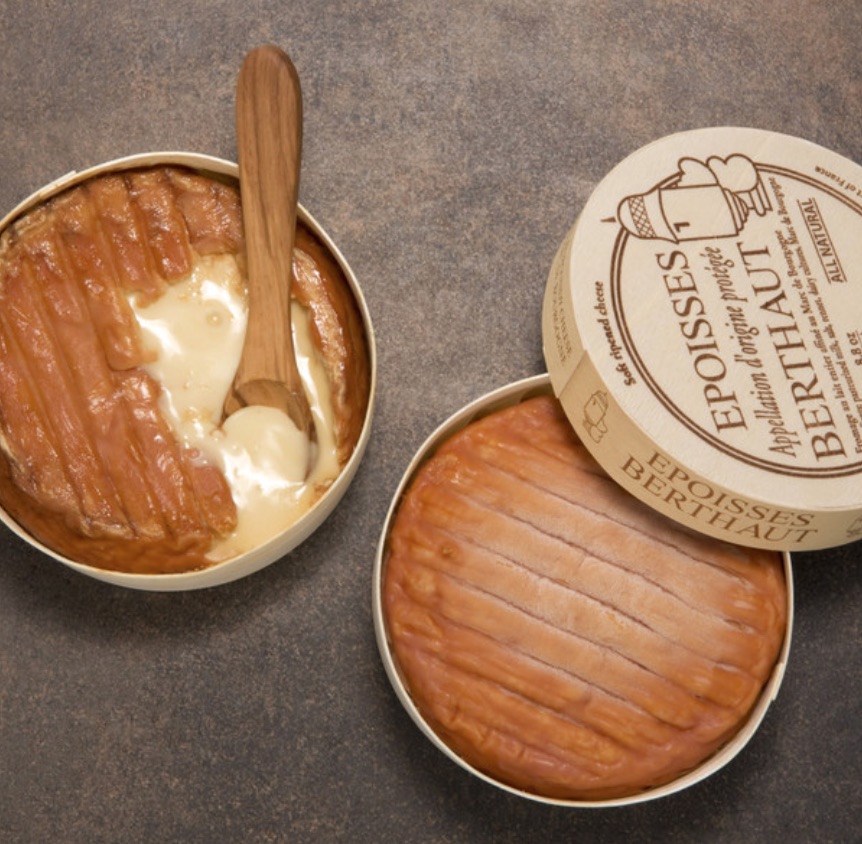Photo: Murray’s Cheese
World Cheese Encyclopaedia - Each Sunday learn all about a cheese in season.
This week Epoisses de Bourgogne from France.
Country: France 🇫🇷
Region: Côte-d'Or, Époisses, Burgundy
Made from: Cow’s milk
Pasteurised: Unpasteurized and pasteurized
Texture: chewy, creamy and firm
Taste: salty, spicy, sweet
Certification: AOC, AOP
Aging: 6 weeks to 2 months
Epoisses de Bourgogne is a soft cow’s milk cheese produced by Jacques Hennart in the village Époisses, France. Commonly called Epoisses, the cheese has a creamy, chewy and firm texture. With a distinctive soft red-orange colour, it is categorized as a smear-ripened cheese washed in marc de Bourgogne. It takes at least 6 weeks to mature fully. Epoisses, is traditionally made with unpasteurized cows’ milk. It has a floral aroma, with a shiny and slightly wrinkled rind. The colour of Epoisses cheese varies from ivory with orange hints to brick red depending principally on the maturing process of the cheese. This red colouring of the rind is caused by the surface bacteria that develop there (Brevibacterium linens). The use of any colourants is strictly forbidden.
Photo: Creative Commons/Traaf, Cheese.com
The cheese itself is pale beige in colour, with a smooth and creamy texture. The heart of the cheese may be slightly crumbly when still young, gradually becoming creamier as it matures. Epoisses was given AOC status in 1991. To make Epoisses, milk is heated to 86F (30C) and held there for 16 hours. After 16 hours, the curd is cut into rough chunks and then placed in molds to drain. The young cheeses drain for 2 days and then are salted and set aside on racks to dry.
As Epoisses ages, it is hand rubbed with a mixture of brine (salt water) and marc. Marc is a rough brandy (think grappa) that is made from the skins, seeds and stems after grapes have been pressed for wine making. This mixture, called pomace, is then fermented to produce marc. As with all washed rind cheeses, this mixture of brine and marc serves a dual purpose. It inhibits mold growth that in turn allows bacteria, which give the cheese its distinctive aroma and flavor, to grow, and it also adds its own flavor to the young cheese.
Photo: The Reluctant Gourmet
The rind is washed three times a week for four to six weeks, at which time it is packed in cool round wooden boxes for sale.
History
This washed rind soft cheese has been produced in France for centuries. The origins of the Epoisses can be found at the Abbaye de Citeaux. It is here that the monks first produced this remarkable complicated cheese. We are told that Napoleon was partial to this cheese and ate it with Chambertin wine. It was very popular in the early part of the twentieth century but disappeared during the second world war. It was only in 1946 that two local Bourguignon families started to produce it. The well known Epicurean Brillat Savarin called it the King of cheeses. Many people consider it one of the most interesting French cheeses. It is often compared to the character of two well known French historic personalities, the Epoisses has the force of Charles le Temeraire and the sensibility of Madame de Sevigne.
Production continued for centuries but was almost forgotten by the mid-20th century. In the 1950s, the Berthaut family of Epoisses (the town) pretty much singlehandedly revived the industry. To this day, the bulk of Epoisses is produced by the Berthauts, although several other artisan cheese makers in the region have entered the Epoisses game.
How to enjoy it
Epoisses A.O.P. goes extremely well with Chardonnay when it is still young, such as a Côte de Beaune, Chassagne-Montrachet or Marc de Bourgogne for example. When it’s more mature, it goes well with a young red, such as a Savigny-les-Beaune.
If you’re serving it with a selection of other cheeses, it’s best to serve it last in order to avoid having its powerful character mask the more subtle flavours of the other cheeses.
Source: Wikipedia, cheese.com, fromages.com, Gaugry, The Reluctant Gourmet




